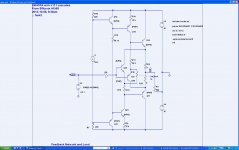Sorry to indulge OT, but this is an issue that keeps coming up --- keeping wines, and waiting for an "occasion".Brad, Scott & co., I don't see how yus guys can keep good wine for so long. Surely you can find an excuse to broach a bottle.
lee sipping his meths in Cooktown ...
I decided that when I resolved some tax matters I'd finally drink a 1988 Krug champagne, but I let the time slip by. So it sits in temp-controlled storage awaiting an occasion.
I had a Henri Jayer red that I brought to a friend's house about thirteen years ago, when I mistakenly believed that the head count at dinner would include about two or three wine drinkers at most. I really wanted the host to experience how good a top-notch burgundy could be, as he had been disappointed and was quite skeptical (he feared, recently, that a well-stored 2005 Dierberg Pinot Noir in magnum would be over the hill!). I was horrified when I arrived and saw a table set for about a dozen people. The wine was opened and concealed in a corner of the kitchen, and two of us periodically and stealthily refilled our glasses. It took a lot of the fun out of it, but I was damned if I was going to see people guzzling it without even noticing what they were drinking, at a then-valuation of ~300 bucks. I had seen this happen with one of the guests with a less-valuable but stunning Chardonnay, the Beringer Sbragia Limited Release of some particularly good year. Glug glug glug, no notice taken.
When I mention a few old wines I have to Marshall Buck, he says Sell them! (he's also apparently had some rather bad luck with things he's kept, and he knows collectors with money abound). And of course good storage is critical, and even then you can wait too long, the wine can deteriorate, and corks can go south and start to interact with the wine.
You can also get too old and too sick. A guy I knew distantly who made a load of dough as a surgeon had an astonishing collection of rarities. I am pretty sure he died before getting round to drinking most of them.
Sites like cellartracker are good for getting updates from discerning people who drink things and make notes, but when there's a negative report it needs corroboration, as it can have been a defective bottle for one reason or another. If there is a general agreement that a wine is fading and well past its peak then it probably is time to move if you've got some. I had a 1943 California Pinot Noir at a friend's not long ago and it was barely drinkable. I declined a second glass, but many at the table thought it was pretty good. I'd say it was a good twenty years too late at least. Some people are just charmed by age and lose objectivity.
what is your choice for test equipment that you will use? Thx-RNM
Just for now I'm trying out a new toy so I can mix work and play a little. Employee privelege gets me one at the $99 price. Pretty cheap for a 14bit USB DSO. It's part of our educational initiative and I'm evaluating it and looking for bugs (found some too).
Digilent Inc. - Digital Design Engineer's Source
Last edited:
I had seen this happen with one of the guests with a less-valuable but stunning Chardonnay, the Beringer Sbragia Limited Release of some particularly good year. Glug glug glug, no notice taken.
.
My worst incident was a friend with anosmia (SY must know what that means) who insisted on pouring a glass of 1962 d'Yquem so they wouldn't feel left out.
Just for now I'm trying out a new toy so I can mix work and play a little. Employee privelege gets me one at the $99 price. Pretty cheap for a 14bit USB DSO.
Digilent Inc. - Digital Design Engineer's Source
Got one about a month ago - pretty nice and usable toy, although the S/W is actually lacking a few functionalities.
L.
Got one about a month ago - pretty nice and usable toy, although the S/W is actually lacking a few functionalities.
L.
You could send any suggestions to me. I found the stream .wav to disk to be unusable, I was very excited at first since I wanted to experiment with some audio stuff. There are no standard sampling rates supported above 16k and the double precision IEEE data makes huge files and is unreadable by almost anything I try (crash and burn with Mediaplayer, Audition, and Cooledit).
Sending the 14bit bit data to a 24/48 or 24/96 file padded with 10 0's makes a lot more sense to me.
My worst incident was a friend with anosmia (SY must know what that means)...
Rovani Syndrome.
so you would recommend waiting a bit before grabbing one of those Scott? ive been looking at something like this, though the +/-20v is a bit limiting. I suppose it could be augmented with some sort of input circuitry? its fine for a lot of projects of course, but its just short of being usable for some of the work I would be wanting to use it for. ive been torn between old analogue scope and something like this for a while now
so you would recommend waiting a bit before grabbing one of those Scott? ive been looking at something like this, though the +/-20v is a bit limiting. I suppose it could be augmented with some sort of input circuitry? its fine for a lot of projects of course, but its just short of being usable for some of the work I would be wanting to use it for. ive been torn between old analogue scope and something like this for a while now
I doubt if the hardware will change, it is a student tool afterall and at $99 it's sort of a no brainer. The biggest complaint so far is the 100MHz sampling but 5MHz analog BW, the arguement being that dealing with aliasing would have added to much cost. The 14 bits is nice most cheap DSO's are 10 bits at best. You can stream ascii text data to a file and open it with most anything so you are not limited to the 16k buffers.
For people to be aware, LTspice allows very high sampling rate material to be dealt with, which then makes analysis of the results meaningful. Downside is, at least in the experiments I've tried, that only samples of very short duration can be crunched, for me LTspice chokes otherwise. I have yet to try using equivalent PWL files, which can then be set on infinite repeat.I found the stream .wav to disk to be unusable, I was very excited at first since I wanted to experiment with some audio stuff. There are no standard sampling rates supported above 16k and the double precision IEEE data makes huge files and is unreadable by almost anything I try (crash and burn with Mediaplayer, Audition, and Cooledit)..
As Scott says, the headache is that to get the precision you need, the file sizes become monstrous and everything becomes difficult and long winded, or just impossible ...
Frank
You could send any suggestions to me.
I'll do it! For those who are interested in this little nice toy, here are a few examples of what it can do. Added a very simple jig to have analog inputs and outputs on BNC:
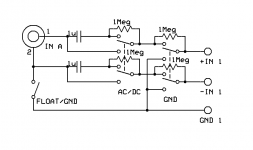
Zout vs freq of a simple 317-based PSU with various output bypass and pretty long cables (-60 dB ~ 100 milliohm):
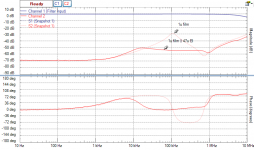
My 239A clone @ 20 Vpp out - given that the clone THD is in the 0.0001% range, it seems that SFDR at ~80 dB is a little lower than expected (and dBV normalization is wrong: for Digilent's WaveForms 0 dBV = 1 Vp instead of 1 Vrms....):
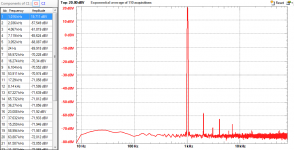
The true 239A thru a double Bainter notch with 40 dB post notch gain (-80 dBV -> -120 dBV) up to 40 kHz- reasonably clean apart from a few hf low level spikes (both the box and the jig are unscreened, but most of the hf noise seems self-generated).
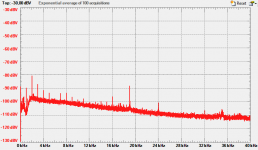
Not an AP at all, but being essentially an educational tool it offers quite a lot for what it costs.
L.
Looks good, thanks. The post notch thing is exactly one of the things I was going to try. I suspect the input null technique would also work well here. I have found the THD of the A/D and DAC's a little more than I had expected. BTW the developer got right back to me (he's actually in Romania).
First Blood
No surprises on the output stage. At no load Gain = .99809, seconds -84dB, thirds -91dB. At 600 Ohm load Gain = .99098, seconds -79.4dB, thirds -80.5dB. Now to proceed to the compete amplifier. I am going to make daughter card for each variant on the input stage and compare with the output being the same.
These results are comparable to the sims, the seconds are a little bigger but that is of little consequence. 0.02% open-loop distortion is pretty good.
No surprises on the output stage. At no load Gain = .99809, seconds -84dB, thirds -91dB. At 600 Ohm load Gain = .99098, seconds -79.4dB, thirds -80.5dB. Now to proceed to the compete amplifier. I am going to make daughter card for each variant on the input stage and compare with the output being the same.
These results are comparable to the sims, the seconds are a little bigger but that is of little consequence. 0.02% open-loop distortion is pretty good.
Attachments
Have had a bit of a play with Scott's output stage, trying 4 combinations of BJT models on a 600R load. Not much variation of the 3rd harmonic, about 2 1/2 db. But for the 2nd there was a variation of 10db, tending to confirm for this circuit that this is more dependent on the accuracy of the model, or characteristics of the real devices.
Frank
Frank
Last edited:
At 8ma of Iq, what class of operation are we in? How far can we push it into class A? Thanks, Ray
Well into class A at 600 Ohm load. Because the collector current of the predrivers is captured you can simply fire it up with the pot zeroed (always turns off the output) and trim measuring the total supply current until it is 8mA greater. BTW you can find the "magic" point where the thirds null, it might make an interesting experiment to adjust the 4.7 Ohm resistors so this happens at ~ 8mA. The values in the above schematic simply reflect what I had in my kit (closest 1% values). We don't stock below 10 Ohms so I simply paralleled two to make 5 Ohms.
A very esoteric point 10k source resistance actually supressed the thirds a little so there must be some vector subtraction going on at the ppm level. So one can see how counter intuitive observations can be made.
Last edited:
Looks I have a lot more to learn here than I initially thought as I only have an understanding for Scotch whiskey
Wine is a patience thing, I find.
Since I do not drink wine or alcohol in general, I'm the perfect person to buy wine and store it. Almost. (have to care enough to commit to the correct storage)
10-15 years later I can approach family or what not at a gathering and bring along "oh, just some crap I had left in the back room, for the past 12-15 years", and they tend to be quite happy with that.
(Not quite that simple, but pretty close)
But if I see a good beer in the fridge or have to pass by the +$100 bottles of hard liquor, or pass by the wine storage, I just drink water. Not even remotely tempted. I'm much happier and more clear headed with that, as experience has taught me.
Its the ~$500 an oz plant matter that keeps catching my eye.... hhhmm..uhhh... no. Must. Not.
Last edited:
Thumbs up Scott! Thanks! And I would like to know how to tweak the sweet spot and null the third. How warm are those 2n4401/03 getting? What voltage swing are we talking about? The JE990 used MJE171/181 to126 transistors. Are we going to have to resort to SLOW heavier output transistors for + & - 18 or 24v operation. I know there must be more modern faster transistors than MJE171/181. GREAT WORK! Ray
Thanks for making us all at the most just four degrees from Obama.
It's really a seemingly weird things, this.
It seems that if one stays around on the planet long enough ...and if one moves into given areas with some energetic will of some sort, one can finally (over the given time) get to the point where one can just 'pick up the phone' and make a connection (at the deepest or most rarefied levels) to just about anyone or any group.
However, one has to be careful with those connections and bridges, IMO and IME. To use them only when actually relevant and pertinent.
It's really a seemingly weird things, this.
I find the two degrees from J Edgar wierder.
I find the two degrees from J Edgar wierder.
Why? Nothing to wear?
jn
- Home
- Source & Line
- Analog Line Level
- Discrete Opamp Open Design
